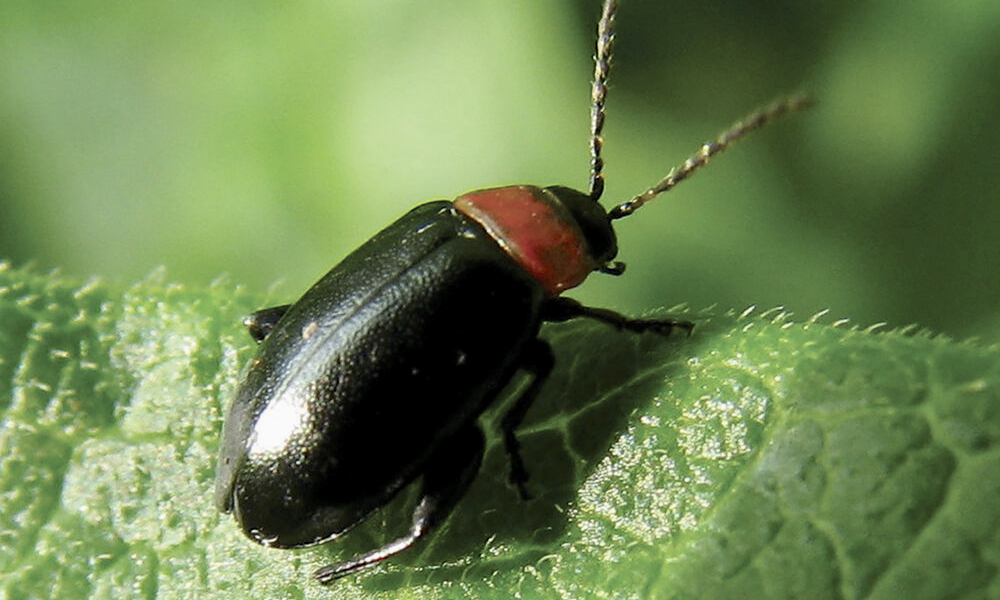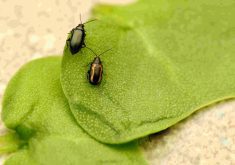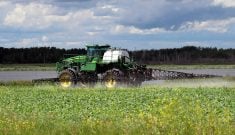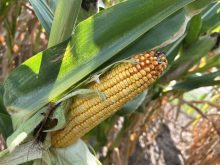Flea beetles and grasshoppers were amongst the biggest insect challenges last season, and they could be set to surge again this year, if conditions are right.
John Gavloski, Manitoba Agriculture and Resource Development entomologist, said both were a huge issue throughout the province.
“They were major concerns over the past season, and when I say major, I mean not just sporadically or locally,” he said. “They were widespread across the province and they were things that many farmers and agronomists had to deal with.”
Flea beetles in canola were the biggest problem of the year and it was the dry conditions that brought it about. The best way to cope with flea beetles is to get the canola past that three- or four-leaf stage where the plants are big enough to tolerate them. The dry spring leading into a dry summer made this difficult, if not impossible.
Read Also

Ag Days Gives Back 2026 focuses on fire response
Manitoba Ag Days charitable program, Ag Days Gives Back, returns for 2026 with a new wave of rural community support in Manitoba and southeast Saskatchewan
The canola was treated with a neonic insecticide that would keep the flea beetles at bay until the plants got the start they needed. The low soil moisture slowed the growth so the tiny plants were nowhere near big enough to cope with flea beetles. They were trapped in that vulnerable cotyledon and first-leaf stages for an extended period and time simply ran out.
“In the mean time the neonics were wearing out, flea beetles were feeding like crazy and people were doing foliar spraying,” Gavloski said. “So people were doing all the right things but when you get years like this it’s still not enough because it’s taking too long for the canola to get to that three- to four-leaf stage.”

The dry spring had some delaying their seeding dates in the hope that there would be some rain to kick-start the emerging crop. It didn’t help. Some of the crops were reseeded after they were damaged beyond repair but it simply wasn’t enough.
But what might farmers expect from flea beetles next year?
“They tend to go to more sheltered areas to overwinter where they like to crawl into leaf litter or debris, often an area with some trees or shrubs,” Gavloski said. “We usually get good winter survival here so don’t count on high winterkill. I would anticipate the flea beetles will be back again.”
Manitoba fields also saw a lot of grasshoppers this past year.
- Read more: Intermittent pests played role last season
That happened because egg laying was quite heavy the previous fall and the spring hatch was prolific enough that farmers were applying insecticide in the ditches.The grasshoppers did well in the dry weather so their populations were big enough that whole fields were sprayed later in the season. The main culprit was the two-striped grasshopper although there were reports of clear-winged as well.
“I had two calls from agronomists in July and in both cases they had very high levels of grasshoppers in a canola field directly across from a pasture but they weren’t really causing a lot of damage to the canola,” Gavloski said. “I think they had a suspicion that they might not be damaging to canola because, in both cases, they did not spray the field and, in both cases, the grasshoppers moved on after a period of time.”
It turned out they were clear-winged grasshoppers feeding in nearby pastures. When the pastures dried down they moved into the canola. As it turned out they really didn’t like the canola so they moved to other areas to feed on their preferred grasses.
“The bottom line is that it’s good to know your grasshoppers,” Gavloski said. “Some of them are picky about what they’re going to feed on and it’s good to know the picky ones from the ones that really don’t care what they’re eating.”
With so many grasshoppers last year, Gavloski noticed a booming population of predators such as bee flies and grey blister beetles. The bee flies will actually follow the grasshoppers and watch where they lay their eggs. Once they’re done, the bee flies lay theirs right beside them so that, on hatching, their larvae can eat the grasshopper eggs. Grey blister beetles do the same thing. Their young are actually specialists on grasshopper eggs so they can put quite a dent in their hatch.
“I had several people call me wondering if these blister beetles were going to be a concern on their canola or their soybeans,” he said. “I was trying to encourage them, unless you’re seeing a lot of defoliation, these insects have a good side in a year with higher grasshopper populations.”
There were also a lot of field crickets and they will feed on grasshopper eggs too. They’re not specialists like the other two and their diet is a lot more cosmopolitan. They’ll eat lots of different things as well as eggs and insect pupa.

“They will dig up grasshopper eggs but to what degree it controls them, hard to know,” Gavloski said. “My guess is probably the bee flies and the blister beetles, the ones that are specialists, do a much better job than the field crickets do. We do encourage people, whenever you can, try to help keep these around because they really do help with your grasshopper control.
“And the other thing I’d just like to mention regarding grasshoppers is that not every grasshopper is a pest grasshopper. I’ve said that many times, I know, at these meetings but it’s worth reinforcing,” he added.
The grasshopper surveys were done in August and the counts were fairly high in several places. Although they may have been lower in others, Gavloski cautions that a full forecast involves more than just the survey. It has to involve the egg-laying conditions for last year and how things are when they emerge in the spring. Grasshoppers should be on your radar.
“We got good egg-laying conditions in August and September. I would encourage people to monitor your field edges and roadsides early in the season. I think grasshoppers need to be on your list as one that could potentially be a big concern going into next year.”















